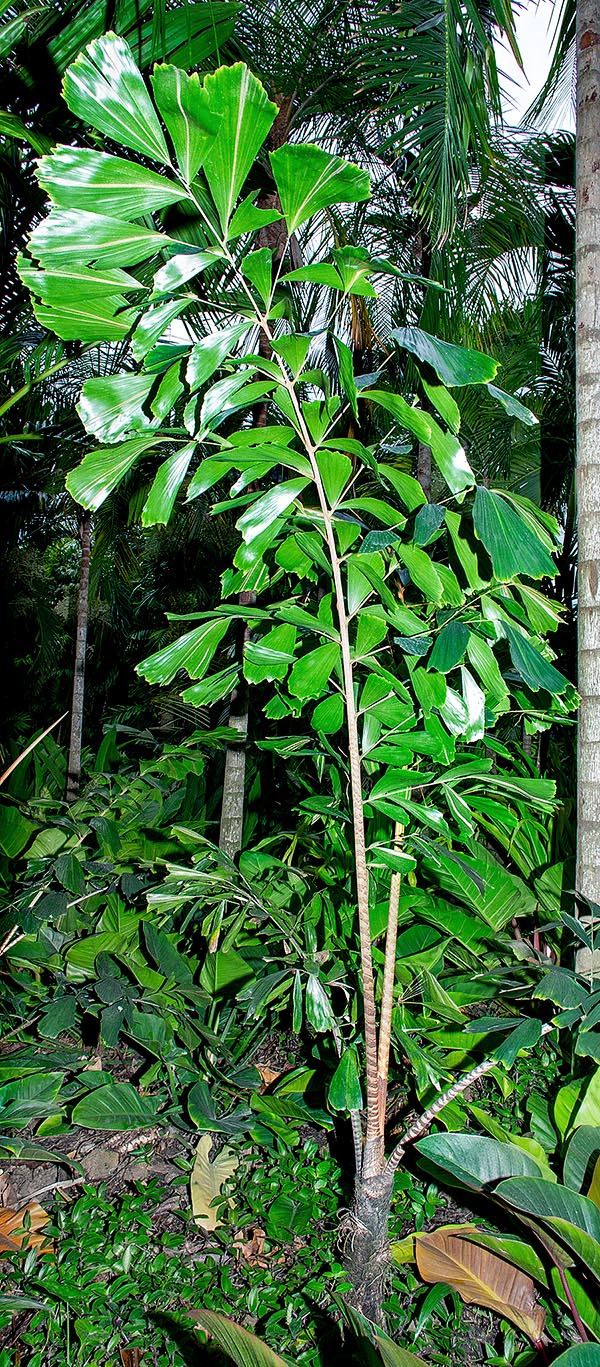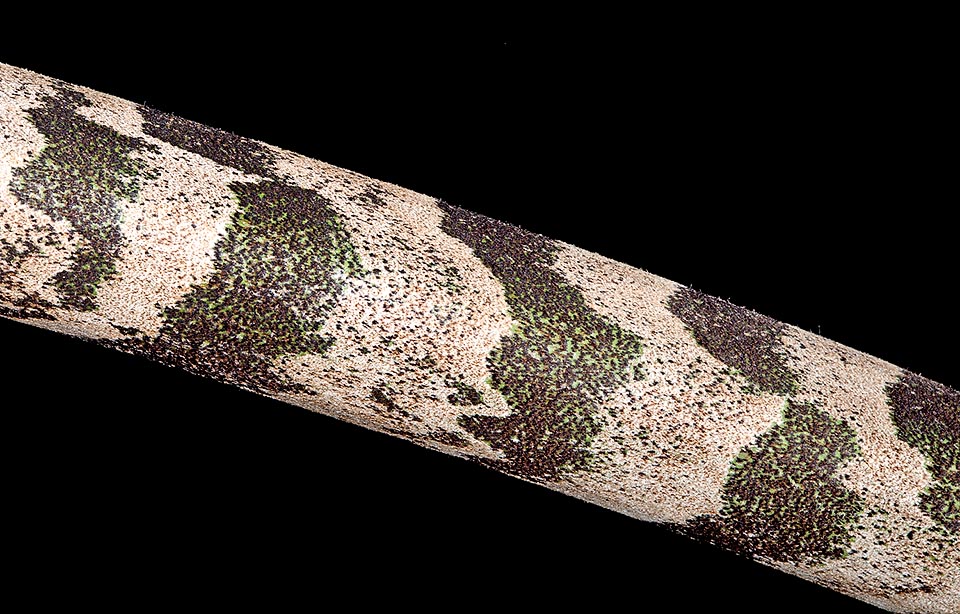Family : Arecaceae

Text © Alessandro Marini

English translation by Mario Beltramini

Only recently discovered, Caryota zebrina is a monocarpic species native to Papua New Guinea © G. Mazza
Caryota zebrina Hambali, Maturb., Heatubun & J.Dransf. is a monocarpic species is native to Papua New Guinea, where it is distributed on the Torricelli Mountains, in the province of West Sepik, in mountain forests between 850 and 1500 m of altitude.
The name of the genus Caryota comes from the Greek “karyótis”, epithet used by Dioscorides to define the date, fruit of the palm.
The name of the species zebrina comes from the Latin and means “relevant to zebra”, with reference to the colouration of parts of the plant.
Common names: Zebra Fishtail Palm, Striped Fishtail Palm, Zebral Palm, Palem Belang, Palem Tokek.
Caryota zebrina has a solitary trunk, up to 16 m tall with a diameter of up to 40 cm, very slow in growing, of grey colour with evident rings forming the remnants of the bases of the fallen leaves, spaced about 20 cm.
The crown of the adult specimens is ample, but able to carry at the same time a maximum of 4 or 5 leaves.
The leaf is bipinnate, up to 6 m long and 1,5 m broad. The rachis is up to 5 m long with primary pinnae inserted with different angulations. This characteristic confers the leaf a disorderly and semi-plumose look.
The secondary pinnae are very thick and coriaceous, of dark green colour, almost blackish and have a triangular shape with toothed outer margin, hence the common name “Zebra fishtail palm”. The secondary pinnae are 7-11 on each side of the primary pinnae, up to 26 cm long and 7 cm broad and are glabrous on the upper side and on the lower one are covered by deciduous brown scales.
The most important characteristic of the species is the colour of the rachis, the petiole and the foliar sheath, that present with zebra stripes alternatively clear and dark, basically clear and brown. The zebra stripes are quite evident on the young and intermediate specimens, but tend to become less marked in the older specimens.
The petioles are smooth and glossy, up to 1,5 m long and up to 3 cm broad. The foliar sheath is 1-2 m long, about 15 cm broad, markedly covered by dark fibres along the margin.
Caryota zebrina is monocarpic, therefore dies after having flowered and fruitified for the first time. The inflorescences develop from the top of the stem downward and usually are formed by one terminal inflorescence and by the underlying ones emerging from the foliar bases. The inflorescences are up to 2,5 m long, on a 30 cm peduncle and can be ramified till the third order, an exclusive characteristic of the species in the genus.
The flowers are united in spirally arranged triads, formed by one female flower sided by two male, and are produced in great quantity.
Initially the fruits are clear and red when ripe, gobose, up to 2,5 cm long. The seeds are usually two, hemispherical, up to 1,5 cm long.
Caryota zebrina is very similar to Caryota ophiopellis, that presents analogous clear and dark bands on parts of the plant. The two species share also the particular shape of the leaf, with the primary pinnae inserted under different angulations on the rachis, differently from all other species of the genus. However, Caryota zebrina distinguishes from Caryota ophiopellis for the secondary pinnae, much darker, thick and coriaceous, with a shape similar to that of the diamond, like in Caryota mitis. The two species differ also in the dimensions, Caryota zebrina has all the parts bigger than Caryota ophiopellis and reaches a height of 16 m compared to the 9 m of the other species.

This palm main characteristic is the zebra colour of the petiole and of the rachis, but also the leaf is special. The crown has only 4 or 5 of them. They are bipinnate, up to 6 m long and 1,5 m broad. The primary pinnae are inserted with different angulations giving the leaves a disorderly and semi-plumose look. The secondary pinnae are dark green © Giuseppe Mazza
Caryota zebrina is a species very sought for by the collectors and is relatively diffused in public and private botanic gardens. However, it is not a species of easy cultivation, especially due to the exceptional slowness in growing, with consequence that the cultivated plants have insufficient reaction times in respect to the evolution of the critical negative factors that may affect them.
Even if coming from Papua New Guinea, it is resident in mountain zones, therefore presents a certain resistance to cold, but in order to have a satisfying growth, it must be cultivated in the tropical and warm subtropical climates. It loves positions in full shade when young, then adapts, when adult, also in a position of mid-sun. It has no particular requirements from what the soil is concerned that must be constantly kept humid but well drained to avoid water stagnation that may aver fatal.
There are no known synonyms for this species discovered only recently, in the year 2000.
